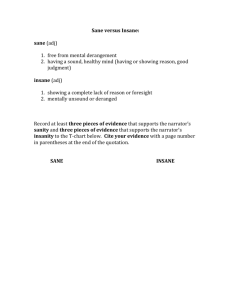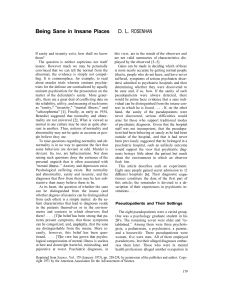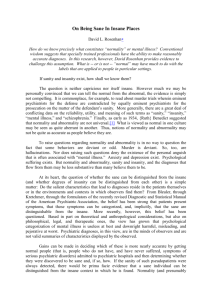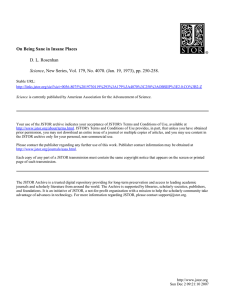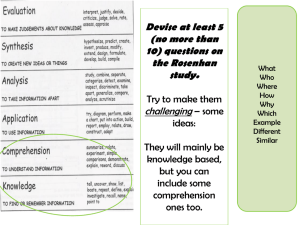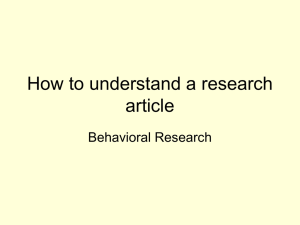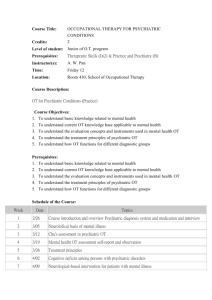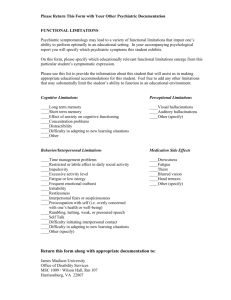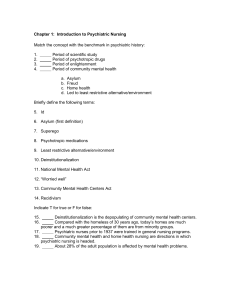On Being Sane In Insane Places
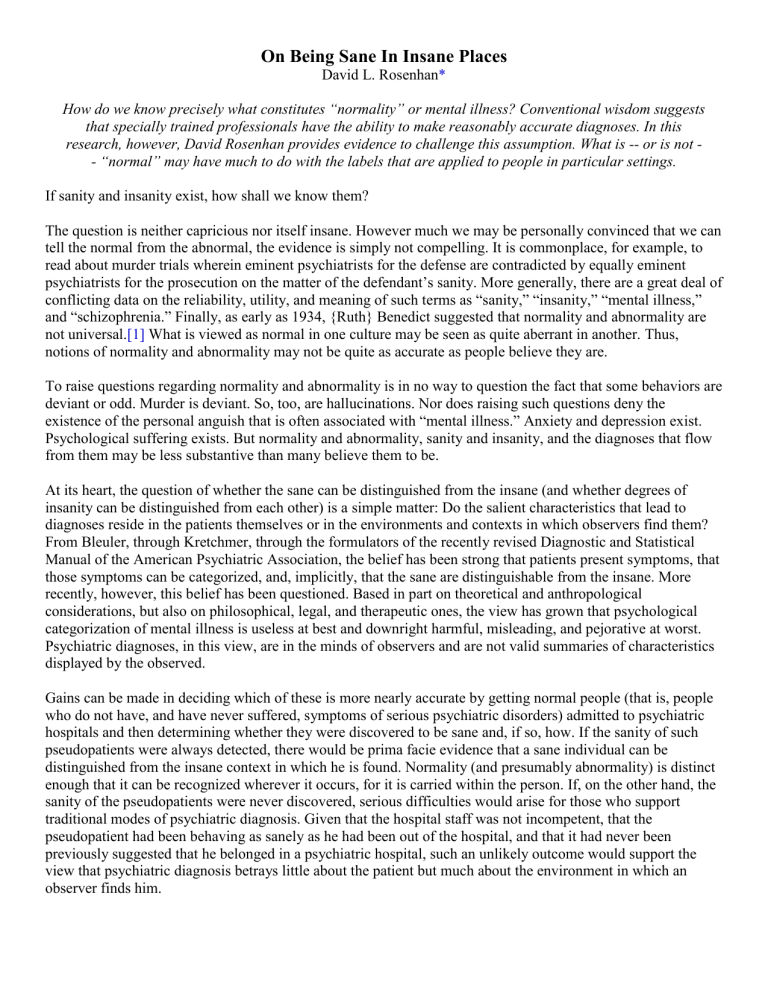
On Being Sane In Insane Places
David L. Rosenhan *
How do we know precisely what constitutes “normality” or mental illness? Conventional wisdom suggests that specially trained professionals have the ability to make reasonably accurate diagnoses. In this research, however, David Rosenhan provides evidence to challenge this assumption. What is -- or is not -
- “normal” may have much to do with the labels that are applied to people in particular settings.
If sanity and insanity exist, how shall we know them?
The question is neither capricious nor itself insane. However much we may be personally convinced that we can tell the normal from the abnormal, the evidence is simply not compelling. It is commonplace, for example, to read about murder trials wherein eminent psychiatrists for the defense are contradicted by equally eminent psychiatrists for the prosecution on the matter of the defendant’s sanity. More generally, there are a great deal of conflicting data on the reliability, utility, and meaning of such terms as “sanity,” “insanity,” “mental illness,” and “schizophrenia.” Finally, as early as 1934, {Ruth} Benedict suggested that normality and abnormality are not universal.
[1] What is viewed as normal in one culture may be seen as quite aberrant in another. Thus, notions of normality and abnormality may not be quite as accurate as people believe they are.
To raise questions regarding normality and abnormality is in no way to question the fact that some behaviors are deviant or odd. Murder is deviant. So, too, are hallucinations. Nor does raising such questions deny the existence of the personal anguish that is often associated with “mental illness.” Anxiety and depression exist.
Psychological suffering exists. But normality and abnormality, sanity and insanity, and the diagnoses that flow from them may be less substantive than many believe them to be.
At its heart, the question of whether the sane can be distinguished from the insane (and whether degrees of insanity can be distinguished from each other) is a simple matter: Do the salient characteristics that lead to diagnoses reside in the patients themselves or in the environments and contexts in which observers find them?
From Bleuler, through Kretchmer, through the formulators of the recently revised Diagnostic and Statistical
Manual of the American Psychiatric Association, the belief has been strong that patients present symptoms, that those symptoms can be categorized, and, implicitly, that the sane are distinguishable from the insane. More recently, however, this belief has been questioned. Based in part on theoretical and anthropological considerations, but also on philosophical, legal, and therapeutic ones, the view has grown that psychological categorization of mental illness is useless at best and downright harmful, misleading, and pejorative at worst.
Psychiatric diagnoses, in this view, are in the minds of observers and are not valid summaries of characteristics displayed by the observed.
Gains can be made in deciding which of these is more nearly accurate by getting normal people (that is, people who do not have, and have never suffered, symptoms of serious psychiatric disorders) admitted to psychiatric hospitals and then determining whether they were discovered to be sane and, if so, how. If the sanity of such pseudopatients were always detected, there would be prima facie evidence that a sane individual can be distinguished from the insane context in which he is found. Normality (and presumably abnormality) is distinct enough that it can be recognized wherever it occurs, for it is carried within the person. If, on the other hand, the sanity of the pseudopatients were never discovered, serious difficulties would arise for those who support traditional modes of psychiatric diagnosis. Given that the hospital staff was not incompetent, that the pseudopatient had been behaving as sanely as he had been out of the hospital, and that it had never been previously suggested that he belonged in a psychiatric hospital, such an unlikely outcome would support the view that psychiatric diagnosis betrays little about the patient but much about the environment in which an observer finds him.
This article describes such an experiment. Eight sane people gained secret admission to 12 different hospitals.
Their diagnostic experiences constitute the data of the first part of this article; the remainder is devoted to a description of their experiences in psychiatric institutions. Too few psychiatrists and psychologists, even those who have worked in such hospitals, know what the experience is like. They rarely talk about it with former patients, perhaps because they distrust information coming from the previously insane. Those who have worked in psychiatric hospitals are likely to have adapted so thoroughly to the settings that they are insensitive to the impact of that experience. And while there have been occasional reports of researchers who submitted themselves to psychiatric hospitalization, these researchers have commonly remained in the hospitals for short periods of time, often with the knowledge of the hospital staff. It is difficult to know the extent to which they were treated like patients or like research colleagues. Nevertheless, their reports about the inside of the psychiatric hospital have been valuable. This article extends those efforts.
PSEUDOPATIENTS AND THEIR SETTINGS
The eight pseudopatients were a varied group. One was a psychology graduate student in his 20’s. The remaining seven were older and “established.” Among them were three psychologists, a pediatrician, a psychiatrist, a painter, and a housewife. Three pseudopatients were women, five were men. All of them employed pseudonyms, lest their alleged diagnoses embarrass them later. Those who were in mental health professions alleged another occupation in order to avoid the special attentions that might be accorded by staff, as a matter of courtesy or caution, to ailing colleagues.
[2] With the exception myself (I was the first pseudopatient and my presence was known to the hospital administration and chief psychologist and, so far as I can tell, to them alone), the presence of pseudopatients and the nature of the research program was not known to the hospital staffs.
[3]
The settings are similarly varied. In order to generalize the findings, admission into a variety of hospitals was sought. The 12 hospitals in the sample were located in five different states on the East and West coasts. Some were old and shabby, some were quite new. Some had good staff-patient ratios, others were quite understaffed.
Only one was a strict private hospital. All of the others were supported by state or federal funds or, in one instance, by university funds.
After calling the hospital for an appointment, the pseudopatient arrived at the admissions office complaining that he had been hearing voices. Asked what the voices said, he replied that they were often unclear, but as far as he could tell they said “empty,” “hollow,” and “thud.” The voices were unfamiliar and were of the same sex as the pseudopatient. The choice of these symptoms was occasioned by their apparent similarity to existential symptoms. Such symptoms are alleged to arise from painful concerns about the perceived meaninglessness of one’s life. It is as if the hallucinating person were saying, “My life is empty and hollow.” The choice of these symptoms was also determined by the absence of a single report of existential psychoses in the literature.
Beyond alleging the symptoms and falsifying name, vocation, and employment, no further alterations of person, history, or circumstances were made. The significant events of the pseudopatient’s life history were presented as they had actually occurred. Relationships with parents and siblings, with spouse and children, with people at work and in school, consistent with the aforementioned exceptions, were described as they were or had been.
Frustrations and upsets were described along with joys and satisfactions. These facts are important to remember. If anything, they strongly biased the subsequent results in favor of detecting insanity, since none of their histories or current behaviors were seriously pathological in any way.
Immediately upon admission to the psychiatric ward, the pseudopatient ceased simulating any symptoms of abnormality. In some cases, there was a brief period of mild nervousness and anxiety, since none of the pseudopatients really believed that they would be admitted so easily. Indeed, their shared fear was that they would be immediately exposed as frauds and greatly embarrassed. Moreover, many of them had never visited a psychiatric ward; even those who had, nevertheless had some genuine fears about what might happen to them.
Their nervousness, then, was quite appropriate to the novelty of the hospital setting, and it abated rapidly.
Apart from that short-lived nervousness, the pseudopatient behaved on the ward as he “normally” behaved. The pseudopatient spoke to patients and staff as he might ordinarily. Because there is uncommonly little to do on a psychiatric ward, he attempted to engage others in conversation. When asked by staff how he was feeling, he indicated that he was fine, that he no longer experienced symptoms. He responded to instructions from attendants, to calls for medication (which was not swallowed), and to dining-hall instructions. Beyond such activities as were available to him on the admissions ward, he spent his time writing down his observations about the ward, its patients, and the staff. Initially these notes were written “secretly,” but as it soon became clear that no one much cared, they were subsequently written on standard tablets of paper in such public places as the dayroom. No secret was made of these activities.
The pseudopatient, very much as a true psychiatric patient, entered a hospital with no foreknowledge of when he would be discharged. Each was told that he would have to get out by his ownd evices, essentially by convincing the staff that he was sane. The psychological stresses associated with hospitalization were considerable, and all but one of the pseudopatients desired to be discharged almost immediately after being admitted. They were, therefore, motivated not only to behave sanely, but to be paragons of cooperation. That their behavior was in no way disruptive is confirmed by nursing reports, which have been obtained on most of the patients. These reports uniformly indicate that the patients were “friendly,” “cooperative,” and “exhibited no abnormal indications.”
THE NORMAL ARE NOT DETECTABLY SANE
Despite their public “show” of sanity, the pseudopatients were never detected. Admitted, except in one case, with a diagnosis of schizophrenia, [4] each was discharged with a diagnosis of schizophrenia “in remission.”
The label “in remission” should in no way be dismissed as a formality, for at no time during any hospitalization had any question been raised about any pseudopatient’s simulation. Nor are there any indications in the hospital records that the pseudopatient’s status was suspect. Rather, the evidence is strong that, once labeled schizophrenic, the pseudopatient was stuck with that label. If the pseudopatient was to be discharged, he must naturally be “in remission”; but he was not sane, nor, in the institution’s view, had he ever been sane.
The uniform failure to recognize sanity cannot be attributed to the quality of the hospitals, for, although there were considerable variations among them, several are considered excellent. Nor can it be alleged that there was simply not enough time to observe the pseudopatients. Length of hospitalization ranged from 7 to 52 days, with an average of 19 days. The pseudopatients were not, in fact, carefully observed, but this failure speaks more to traditions within psychiatric hospitals than to lack of opportunity.
Finally, it cannot be said that the failure to recognize the pseudopatients'sanity was due to the fact that they were not behaving sanely. While there was clearly some tension present in all of them, their daily visitors could detect no serious behavioral consequences—nor, indeed, could other patients. It was quite common for the patients to “detect” the pseudopatient’s sanity. During the first three hospitalizations, when accurate counts were kept, 35 of a total of 118 patients on the admissions ward voiced their suspicions, some vigorously.
“You’re not crazy. You’re a journalist, or a professor (referring to the continual note-taking). You’re checking up on the hospital.” While most of the patients were reassured by the pseudopatient’s insistence that he had been sick before he came in but was fine now, some continued to believe that the pseudopatient was sane throughout his hospitalization. The fact that the patients often recognized normality when staff did not raises important questions.
Failure to detect sanity during the course of hospitalization may be due to the fact that physicians operate with a strong bias toward what statisticians call the Type 2 error. This is to say that physicians are more inclined to call a healthy person sick (a false positive, Type 2) than a sick person healthy (a false negative, Type 1). The reasons for this are not hard to find: it is clearly more dangerous to misdiagnose illness than health. Better to err on the side of caution, to suspect illness even among the healthy.
But what holds for medicine does not hold equally well for psychiatry. Medical illnesses, while unfortunate, are not commonly pejorative. Psychiatric diagnoses, on the contrary, carry with them personal, legal, and social stigmas. It was therefore important to see whether the tendency toward diagnosing the sane insane could be reversed. The following experiment was arranged at a research and teaching hospital whose staff had heard these findings but doubted that such an error could occur in their hospital. The staff was informed that at some time during the following three months, one or more pseudopatients would attempt to be admitted into the psychiatric hospital. Each staff member was asked to rate each patient who presented himself at admissions or on the ward according to the likelihood that the patient was a pseudopatient. A 10-point scale was used, with a 1 and 2 reflecting high confidence that the patient was a pseudopatient.
Judgments were obtained on 193 patients who were admitted for psychiatric treatment. All staff who had had sustained contact with or primary responsibility for the patient – attendants, nurses, psychiatrists, physicians, and psychologists – were asked to make judgments. Forty-one patients were alleged, with high confidence, to be pseudopatients by at least one member of the staff. Twenty-three were considered suspect by at least one psychiatrist. Nineteen were suspected by one psychiatrist and one other staff member. Actually, no genuine pseudopatient (at least from my group) presented himself during this period.
The experiment is instructive. It indicates that the tendency to designate sane people as insane can be reversed when the stakes (in this case, prestige and diagnostic acumen) are high. But what can be said of the 19 people who were suspected of being “sane” by one psychiatrist and another staff member? Were these people truly
"sane" or was it rather the case that in the course of avoiding the Type 2 error the staff tended to make more errors of the first sort – calling the crazy “sane”? There is no way of knowing. But one thing is certain: any diagnostic process that lends itself too readily to massive errors of this sort cannot be a very reliable one.
THE STICKINESS OF PSYCHODIAGNOSTIC LABELS
Beyond the tendency to call the healthy sick – a tendency that accounts better for diagnostic behavior on admission than it does for such behavior after a lengthy period of exposure – the data speak to the massive role of labeling in psychiatric assessment. Having once been labeled schizophrenic, there is nothing the pseudopatient can do to overcome the tag. The tag profoundly colors others’ perceptions of him and his behavior.
From one viewpoint, these data are hardly surprising, for it has long been known that elements are given meaning by the context in which they occur. Gestalt psychology made the point vigorously, and
Asch [5] demonstrated that there are “central” personality traits (such as “warm” versus “cold”) which are so powerful that they markedly color the meaning of other information in forming an impression of a given personality. “Insane,” “schizophrenic,” “manic-depressive,” and “crazy” are probably among the most powerful of such central traits. Once a person is designated abnormal, all of his other behaviors and characteristics are colored by that label. Indeed, that label is so powerful that many of the pseudopatients’ normal behaviors were overlooked entirely or profoundly misinterpreted. Some examples may clarify this issue.
Earlier, I indicated that there were no changes in the pseudopatient’s personal history and current status beyond those of name, employment, and, where necessary, vocation. Otherwise, a veridical description of personal history and circumstances was offered. Those circumstances were not psychotic.
How were they made consonant with the diagnosis modified in such a way as to bring them into accord with the circumstances of the pseudopatient’s life, as described by him?
As far as I can determine, diagnoses were in no way affected by the relative health of the circumstances of a pseudopatient’s life. Rather, the reverse occurred: the perception of his circumstances was shaped entirely by the diagnosis. A clear example of such translation is found in the case of a pseudopatient who had had a close
relationship with his mother but was rather remote from his father during his early childhood. During adolescence and beyond, however, his father became a close friend, while his relationship with his mother cooled. His present relationship with his wife was characteristically close and warm. Apart from occasional angry exchanges, friction was minimal. The children had rarely been spanked. Surely there is nothing especially pathological about such a history. Indeed, many readers may see a similar pattern in their own experiences, with no markedly deleterious consequences. Observe, however, how such a history was translated in the psychopathological context, this from the case summary prepared after the patient was discharged.
This white 39-year-old male . . . manifests a long history of considerable ambivalence in close relationships, which begins in early childhood. A warm relationship with his mother cools during his adolescence. A distant relationship with his father is described as becoming very intense. Affective stability is absent. His attempts to control emotionality with his wife and children are punctuated by angry outbursts and, in the case of the children, spankings. And while he says that he has several good friends, one senses considerable ambivalence embedded in those relationships also . . .
The facts of the case were unintentionally distorted by the staff to achieve consistency with a popular theory of the dynamics of a schizophrenic reaction. Nothing of an ambivalent nature had been described in relations with parents, spouse, or friends. To the extent that ambivalence could be inferred, it was probably not greater than is found in all human’s relationships. It is true the pseudopatient’s relationships with his parents changed over time, but in the ordinary context that would hardly be remarkable – indeed, it might very well be expected.
Clearly, the meaning ascribed to his verbalizations (that is, ambivalence, affective instability) was determined by the diagnosis: schizophrenia. An entirely different meaning would have been ascribed if it were known that the man was “normal.”
All pseudopatients took extensive notes publicly. Under ordinary circumstances, such behavior would have raised questions in the minds of observers, as, in fact, it did among patients. Indeed, it seemed so certain that the notes would elicit suspicion that elaborate precautions were taken to remove them from the ward each day. But the precautions proved needless. The closest any staff member came to questioning those notes occurred when one pseudopatient asked his physician what kind of medication he was receiving and began to write down the response. “You needn’t write it,” he was told gently. “If you have trouble remembering, just ask me again.”
If no questions were asked of the pseudopatients, how was their writing interpreted? Nursing records for three patients indicate that the writing was seen as an aspect of their pathological behavior. “Patient engaged in writing behavior” was the daily nursing comment on one of the pseudopatients who was never questioned about his writing. Given that the patient is in the hospital, he must be psychologically disturbed. And given that he is disturbed, continuous writing must be behavioral manifestation of that disturbance, perhaps a subset of the compulsive behaviors that are sometimes correlated with schizophrenia.
One tacit characteristic of psychiatric diagnosis is that it locates the sources of aberration within the individual and only rarely within the complex of stimuli that surrounds him. Consequently, behaviors that are stimulated by the environment are commonly misattributed to the patient’s disorder. For example, one kindly nurse found a pseudopatient pacing the long hospital corridors. “Nervous, Mr. X?” she asked. “No,bored,” he said.
The notes kept by pseudopatients are full of patient behaviors that were misinterpreted by wellintentioned staff.
Often enough, a patient would go “berserk” because he had, wittingly or unwittingly, been mistreated by, say, an attendant. A nurse coming upon the scene would rarely inquire even cursorily into the environmental stimuli of the patient’s behavior. Rather, she assumed that his upset derived from his pathology, not from his present interactions with other staff members. Occasionally, the staff might assume that the patient’s family (especially when they had recently visited) or other patients had stimulated the outburst. But never were the staff found to assume that one of themselves or the structure of the hospital had anything to do with a patient’s behavior. One psychiatrist pointed to a group of patients who were sitting outside the cafeteria entrance half an hour before lunchtime. To a group of young residents he indicated that such behavior was characteristic of the oral-
acquisitive nature of the syndrome. It seemed not to occur to him that there were very few things to anticipate in a psychiatric hospital besides eating.
A psychiatric label has a life and an influence of its own. Once the impression has been formed that the patient is schizophrenic, the expectation is that he will continue to be schizophrenic. When a sufficient amount of time has passed, during which the patient has done nothing bizarre, he is considered to be in remission and available for discharge. But the label endures beyond discharge, with the unconfirmed expectation that he will behave as a schizophrenic again. Such labels, conferred by mental health professionals, are as influential on the patient as they are on his relatives and friends, and it should not surprise anyone that the diagnosis acts on all of them as a self-fulfilling prophecy. Eventually, the patient himself accepts the diagnosis, with all of its surplus meanings and expectations, and behaves accordingly.
The inferences to be made from these matters are quite simple. Much as Zigler and Phillips have demonstrated that there is enormous overlap in the symptoms presented by patients who have been variously diagnosed, [6] so there is enormous overlap in the behaviors of the sane and the insane. The sane are not “sane” all of the time.
We lose our tempers “for no good reason.” We are occasionally depressed or anxious, again for no good reason.
And we may find it difficult to get along with one or another person – again for no reason that we can specify.
Similarly, the insane are not always insane. Indeed, it was the impression of the pseudopatients while living with them that they were sane for long periods of time – that the bizarre behaviors upon which their diagnoses were allegedly predicated constituted only a small fraction of their total behavior. If it makes no sense to label ourselves permanently depressed on the basis of an occasional depression, then it takes better evidence than is presently available to label all patients insane or schizophrenic on the basis of bizarre behaviors or cognitions. It seems more useful, as Mischel [7] has pointed out, to limit our discussions to behaviors the stimuli that provoke them, and their correlates.
It is not known why powerful impressions of personality traits, such as “crazy” or “insane,” arise. Conceivably, when the origins of and stimuli that give rise to a behavior are remote or unknown, or when the behavior strikes us as immutable, trait labels regarding the behavior arise. When, on the other hand, the origins and stimuli are known and available, discourse is limited to the behavior itself. Thus, I may hallucinate because I am sleeping, or I may hallucinate because I have ingested a peculiar drug. These are termed sleep-induced hallucinations, or dreams, and drug-induced hallucinations, respectively. But when the stimuli to my hallucinations are unknown, that is called craziness, or schizophrenia –as if that inference were somehow as illuminating as the others.
THE EXPERIENCE OF PSYCHIATRIC HOSPITALIZATION
The term “mental illness” is of recent origin. It was coined by people who were humane in their inclinations and who wanted very much to raise the station of (and the public’s sympathies toward) the psychologically disturbed from that of witches and “crazies” to one that was akin to the physically ill. And they were at least partially successful, for the treatment of the mentally ill has improved considerably over the years. But while treatment has improved, it is doubtful that people really regard the mentally ill in the same way that they view the physically ill. A broken leg is something one recovers from, but mental illness allegedly endures forever. A broken leg does not threaten the observer, but a crazy schizophrenic? There is by now a host of evidence that attitudes toward the mentally ill are characterized by fear, hostility, aloofness, suspicion, and dread. The mentally ill are society’s lepers.
